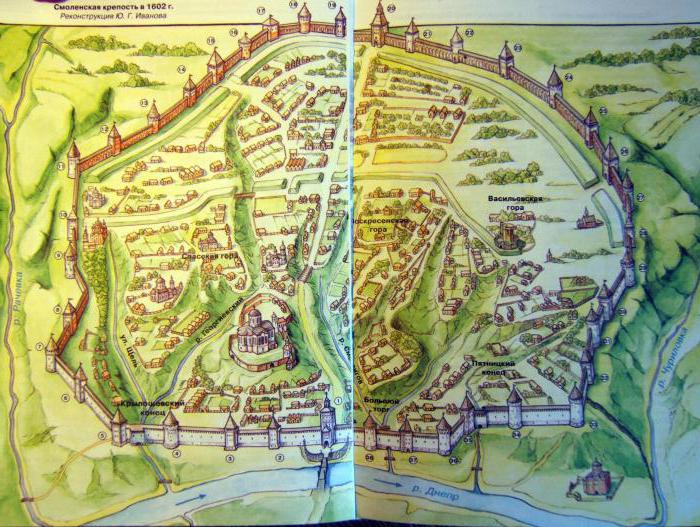Smolensk is an old Russian city that regularly suffered from its European neighbors due to its geographical location. During the reign of Fedor Ioannovich and Boris Godunov, the Smolensk Kremlin was erected. This fortification is unique in many ways. For a long time, the fortress was considered the largest and most reliable in all of Europe.
The history of the construction of an impregnable fortress
In 1596, construction began on a
stone fortress in Smolensk. The main architect of the project was Fedor Savelyevich Kon. It was
this architect who led the construction of the Moscow Kremlin around the White City. According to the author, the new fortress was to surpass all that existed in our country earlier. Thanks to the competent organization of work and the forces of thousands of workers, the Smolensk Kremlin was completed and put into operation a few years after the foundation was laid. The total length of the walls is about 6.5 km. At that time, fortifications were built in many cities. Usually they were modest in size, ordinary people settled outside the walls. In the event of an attack by enemies, the entire population of the city took refuge in a fortress and proceeded to defense. The situation was completely different in Smolensk. The new fortress wall encircled the whole city; there were no settlements beyond its perimeter.
Description and scheme of the Smolensk Kremlin
Initially, the fortress walls formed a complex irregular closed figure, one side of which stretched along the Dnieper. The Kremlin had 38 towers, 7 of which were travel (had a gate). The wall thickness was 4-6 meters, in some places their height was 16 meters. Additionally, the fortress was protected by an earthen rampart and a moat. The main gate had a lifting mechanism. The Smolensk Kremlin was a real miracle of engineering. Its walls had three levels of battle: plantar, middle and upper. For its time, this is an important invention of military architecture.
Smolensk fortress in military history
In 1609, Sigismund III advanced with an army of about 22,000 soldiers to Smolensk. The defense of the city was led by the local governor M. B. Shein. The forces were initially unequal, since there were only about 5,000 defenders in Smolensk. But, despite this fact, the city did not give up as much as 20 months. During the siege, the Smolensk warriors demonstrated valor and courage. Gradually running out of food and firewood, due to unsanitary conditions, massive diseases were noted. In the spring of 1610, 150 people died every day, but the defenders of the city were not going to give up. The Smolensk Kremlin was occupied by attackers only in the summer of 1611. In 1654, after the Russo-Polish war, the fortress was returned to the Russian kingdom. Smolensk fortress was significantly affected during the Patriotic War of 1812. The Kremlin lost 8 towers, but some sections of the walls could still be used for defense.
Surviving towers

Once the fortress in Smolensk boasted 38 towers. Only 17 of them have survived to our time. Volkova Tower (Volkhovskaya, Semenskaya, Strelka) was rebuilt during the restoration in 1877. The fate of the Kostyrev (Porokhovaya, Red) tower is similar. The building erected after complete destruction was restored today, inside there is an existing cafe. The Luchinsky Tower, or Veselukha, is one of the most beloved vacation spots of citizens, from its foot an incredibly picturesque view of the surroundings opens. The following towers of the Smolensk Kremlin have survived to this day: Pozdnyakova (Rogovka), Gorodetskaya (Orel), Avraamievskaya, Zaaltarnaya (Belukha), Shemelevka, Zimbulka, Voronin, Nikolsky Gate, Makhovaya. The most interesting for tourists is Gromovaya - there is a branch of the historical museum in it, and Donets, near which you can see memorials dedicated to the defenders of the city of 1812 and 1941-1945. Kopytitsky gates were preserved almost in their original form; they got their name in honor of the road along which herds were driven out to pastures before the construction of the Kremlin. Unusually named and tower of Bubleyka. According to legends, sound signals were sent from her when opponents approached. In place of the Pyatnitsky Gate today stands the Church of St. Nicholas the Wonderworker, built in 1816. Another new building of the Kremlin is the Kassandalovskaya tower, a museum dedicated to the Great Patriotic War is opened in it today. A temple was erected on the site of the Dnieper Gate in 1793, and today a Sunday school is opened here.
The main attraction of Smolensk today
From the great Smolensk fortress to our days, only 17 towers and fragments of walls have been preserved. During walks in the city center, tourists have the opportunity to accidentally come across the surviving elements of an ancient fortification. The Smolensk Kremlin, whose history is closely intertwined with the history of our state, is recognized as a monument of Russian architecture of the 16th-17th centuries. It has been restored several times, but there is no talk of a complete restoration of this building. The surviving towers are in various conditions, in some of them museums are open for tourists, in others some public and commercial organizations. It is worth noting that even in its current state, the walls of the Smolensk Kremlin look amazing. Be sure to visit this unique attraction in person when traveling to Smolensk.